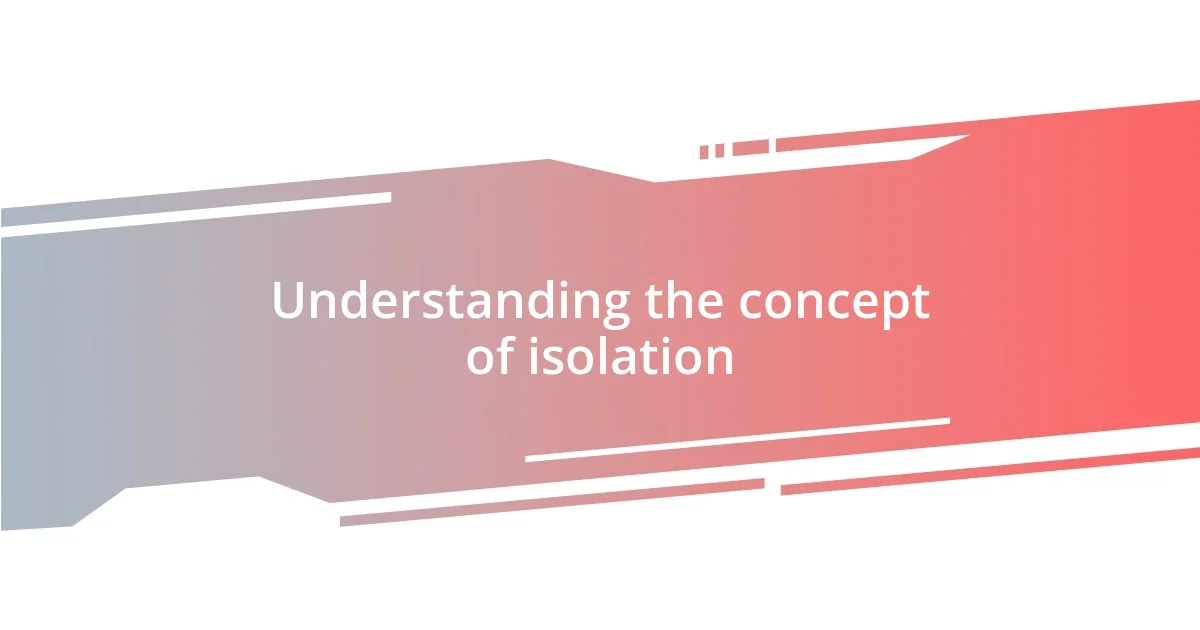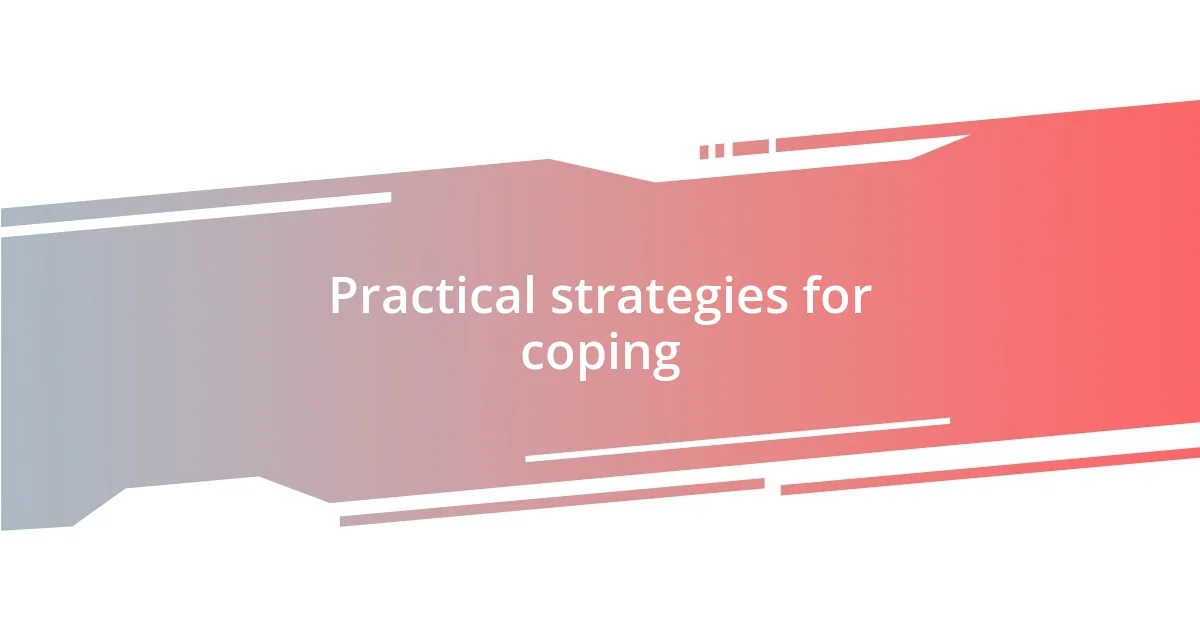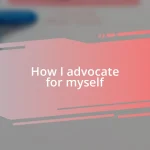Key takeaways:
- Isolation has dual effects: it can foster personal growth through solitude, but it can also lead to loneliness and mental health challenges.
- Recognizing signs of isolation, such as withdrawal from activities and emotional shifts, is crucial in addressing feelings of disconnection.
- Engaging in meaningful activities, building a support network, and maintaining mental and physical health are effective strategies for coping with isolation.

Understanding the concept of isolation
Isolation can often feel like a double-edged sword. On one hand, it can provide us with the solitude we crave, allowing for reflection and personal growth. But on the other, it can lead to feelings of loneliness and disconnect from the world. I remember a time when, after a major life change, I found myself choosing solitude over socializing. It felt comforting at first, but soon, I realized that isolation was becoming a heavy weight rather than a source of peace.
Diving deeper into what isolation truly means, I’ve found it can manifest in various forms—whether it’s physical isolation, where we’re cut off from others due to circumstances, or emotional isolation, where we feel disconnected even when surrounded by people. Have you ever felt like you were in a crowded room, yet completely alone? That sensation can be haunting. I’ve experienced it during family gatherings, where laughter echoes around me, yet I felt miles away, trapped in my own thoughts.
Understanding isolation also means recognizing its impact on our mental health. I’ve experienced days when isolation spiraled into anxiety, creating a personal cycle that was difficult to break. It made me wonder, how often do we allow ourselves to sit with those feelings? I’ve learned that identifying and acknowledging those sensations of isolation is the first step in navigating its complexities.

Recognizing the signs of isolation
When grappling with isolation, it’s essential to tune into the subtle signs that may signal you’re distancing yourself from others. For me, the initial indicator often surfaces as a sense of disinterest. I remember a period where I found it increasingly difficult to pick up the phone, even when friends reached out. Days turned into weeks, and I noticed my usual hobbies, which brought me joy, began to feel burdensome instead.
Here are some key signs that might suggest you’re experiencing isolation:
– Withdrawal from social activities: You decline invitations, even those you once looked forward to.
– Changes in communication: Texts and calls go unanswered; you avoid engaging with people.
– Physical symptoms: Fatigue, restlessness, or difficulty sleeping become more pronounced.
– Emotional shifts: Feelings of sadness or irritability creep in, often unprovoked.
– Loss of interest: Hobbies or interests you used to love suddenly feel unappealing.
Recognizing these signs can serve as a wake-up call. I often reflect on my own experiences, where a simple change—a friend reaching out or a new activity—could dramatically shift that heavy feeling of isolation into something lighter. It’s a powerful reminder that acknowledging our state is the first step toward reconnecting with the world around us.

Practical strategies for coping
I’ve discovered several practical strategies for coping with isolation that can genuinely shift our perspectives. One technique I’ve found particularly useful is establishing a daily routine. For instance, during a particularly isolating period in my life, I started setting simple, achievable goals for each day—like making my bed or going for a short walk. This little structure helped me regain a sense of purpose and connectedness to my day, even when I felt physically alone.
Another effective strategy is reaching out to others, even when it feels challenging. I vividly remember times when I hesitated to call friends, fearing they wouldn’t understand. However, when I did take that leap, I was often met with such understanding and warmth. A simple text or call can break that wall of isolation and remind us that we’re part of a community, even if it’s just a voice on the other end of the line. Initiating contact not only reassured me but also opened up channels for deeper, meaningful conversations, which were a balm for loneliness.
Lastly, I’ve learned the power of creative expression as a coping mechanism. During stretches of solitude, I turned to journaling. It became my safe space to explore thoughts and emotions without judgment. Writing allowed me to articulate feelings I couldn’t express verbally, and sometimes, seeing my struggles on paper made them feel less daunting. I encourage you to find a creative outlet that resonates with you, whether it’s painting, writing, or even cooking. That act of creation can be profoundly therapeutic and offer an escape from the heaviness of isolation.
| Strategy | Benefits |
|---|---|
| Establishing a daily routine | Provides structure and purpose, reducing feelings of aimlessness. |
| Reaching out to others | Enhances connection and reminds us we’re not truly alone. |
| Creative expression | Offers an outlet for emotions, promoting self-discovery and healing. |

Building a support network
Building a support network begins with recognizing the importance of connection. I remember a time when I felt particularly lonely, and it struck me how vital it was to reach out. Despite my hesitation, I decided to reconnect with two old friends over coffee. That simple act opened the door not only to laughter but also to deeper conversations about our challenges, reminding me that vulnerability creates space for support.
Engaging in community activities has also been a game-changer for me. Joining groups focused on shared interests, like a local book club or a hiking group, has proven invaluable. Can you imagine being surrounded by people who share your passions? I’ve met individuals who have become friends simply through discussing novels or exploring nature together. It’s comforting to find like-minded souls, and you quickly realize the sense of camaraderie can alleviate feelings of isolation.
Finally, don’t underestimate the digital landscape when building a support network. I’ve found that online forums or social media groups often cultivate a sense of belonging that complements in-person interactions. During some of my lonelier days, joining an online community focused on mental health provided me with a platform to share experiences and receive encouragement. It’s remarkable how a message from a stranger can feel like a lifeline, showing us that our struggles are not ours to bear alone.

Engaging in meaningful activities
Engaging in meaningful activities has been a transformative part of my journey through isolation. For instance, I recently took up gardening. Initially, I thought it would just be a way to pass the time, but digging into the soil and nurturing plants brought me a sense of accomplishment and joy. There’s something magical about watching life bloom, a reminder that growth happens slowly yet surely, just like our own emotional healing.
I also discovered the joy of volunteering when I felt the weight of loneliness pressing down on me. Helping at a local animal shelter not only filled my days with purpose but connected me with people who shared my love for animals. Every wagging tail and grateful purr reminded me that I was contributing to something larger than myself. Have you ever experienced the rush of joy that comes from making even the smallest difference in someone else’s life? It’s a beautiful antidote to isolation.
The beauty of engaging in meaningful activities lies in their ability to evoke creativity and self-discovery. I recall when I picked up photography—each click of the camera taught me to see the world anew. It’s exhilarating to capture a moment that resonates with me and to find beauty in the mundane. This practice has not only been a creative outlet but also a way to reflect on my feelings. By documenting life’s fleeting moments, I’ve learned to appreciate and reflect on my experiences, fostering a deeper connection to both myself and my surroundings.

Maintaining mental and physical health
Maintaining mental and physical health is essential during times of isolation. I’ve learned that incorporating regular exercise into my routine makes a world of difference. Once, after a particularly stagnant week, I decided to go for a brisk walk in the local park. The fresh air, the sound of leaves rustling, and the rhythm of my footsteps rejuvenated my spirit. I felt lighter, both physically and mentally, as if I’d shaken off some of that heavy isolation.
Eating right didn’t always come naturally to me, especially when I felt down. Yet, I found that preparing nourishing meals was a form of self-care I could practice daily. On days when I forced myself to chop vegetables and create colorful salads, I noticed an emotional lift that accompanied it. There’s something empowering about choosing what goes into your body, isn’t there? It became a small act of control amidst the chaos of feeling alone.
Mindfulness practices have also become a crucial pillar in my well-being. Meditation at sunrise has become a cherished ritual; the stillness of those early moments helps center my thoughts. I remember one morning, as I focused on my breath, feeling a wave of gratitude wash over me—gratitude for the moment, for the sun peeking over the horizon, and for the chance to start anew. It’s a reminder that even in solitude, there’s a connection to something greater, helping me maintain a sense of balance and peace.

Creating a long-term isolation plan
Creating a long-term isolation plan requires careful consideration of what truly sustains us over time. When I first began to outline my plan, I reflected on what brought me joy during moments alone. Rather than just filling my schedule, I decided to prioritize activities that genuinely resonated with me, like reading novels that transport me to other worlds. Have you ever lost track of time when you’re immersed in a great book? That’s the magic I aimed to cultivate regularly.
Setting clear goals also played a crucial role in my isolation strategy. In the beginning, I wrote down my aspirations for both personal growth and emotional well-being. One of my goals was to learn a new language. Each week, I carved out specific times for practice, rewarding myself for the progress I made. Those small victories kept me motivated and reminded me that I was actively working toward something. How rewarding it is to see yourself evolve, even while facing challenges!
Moreover, I found it helpful to incorporate flexibility in my plan. Life can be unpredictable, and there were days when my motivation dipped significantly. I learned to give myself grace during those times. Instead of sticking rigidly to my plan, I reshuffled activities or allowed for spontaneous moments. Embracing the unexpected not only alleviated pressure but often led to surprising joys, like discovering a new favorite podcast or taking a short impromptu road trip. It’s essential to create a plan that feels supportive rather than restrictive, don’t you think?















